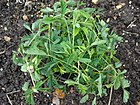Note: This is a project under development. The articles on this wiki are just being initiated and broadly incomplete. You can Help creating new pages.
Mimosa pudica - Lajjika
Lajjika is an annual to perennial, more or less prostrate creeping plant. The plant can grow up to 1 metre tall, but is more likely to be 15 - 45cm tall, the stems usually becoming woody. The plant is gathered from the wild for local medicinal use. It is cultivated as a green manure and for soil stabilization, and is sometimes also cultivated for its uses in folk medicine. Probably arose in the Neotropics, but now Pantropical.
Uses
Female reproductive disorders, Diarrhea, Bleeding disorders, Ulcers, Inflammation, Gastritis, Fatigue, Asthma, Skin diseases [1]
Parts Used
Chemical Composition
Common names
| Language | Common name |
|---|---|
| Kannada | naachike gida, naachike mullu, ganda kaali, hadergitte, lajja, lajjaavathi |
| Hindi | chui mui, lajalu, lajawanti, lajjavanti, lajjavati |
| Malayalam | thendarmani, thotavadi, tindarmani |
| Tamil | alavananki, cuntiyilai, thottal shurungi |
| Telugu | atthapatthi, lajjavanthi, manugumaramu, mudatha damara, munuguda, muttavapulagamu-chettu, nidrakanti |
| Marathi | NA |
| Gujarathi | NA |
| Punjabi | NA |
| Kashmiri | NA |
| Sanskrit | ajalikalika, alambusa, anjalikaraka, khadiraka, khadirpatrika, namaskari, prasarini, raktamula, shamipatra |
| English | Sensitive plant |
Properties
Reference: Dravya - Substance, Rasa - Taste, Guna - Qualities, Veerya - Potency, Vipaka - Post-digesion effect, Karma - Pharmacological activity, Prabhava - Therepeutics.
Dravya
Rasa
Tikta (Bitter), Kashaya (Pungent)
Guna
Laghu (Light), Rooksha (Dry)
Veerya
Sheeta (cold)
Vipaka
Katu (Pungent)
Karma
Pitta, Kapha
Prabhava
Habit
Identification
Leaf
| Kind | Shape | Feature |
|---|---|---|
| Bipinnate | alternate | Borne on stalks (i.e. petioles) 15-60 mm long. They consist of one or two pairs of branchlets (i.e. pinnae) that often have a covering of stiff, prickly, bristles. Each of these branchlets (2.5-8 cm long) bears 10-25 pairs of small dark green leaflets. The leaflets are elongated or oblong in shape (6-15 mm long and 1-3 mm wide) with entire margins. Both surfaces of the leaflets are sparsely hairy (i.e. puberulent) and their margins are lined with tiny bristly hairs. The leaves are very sensitive and fold up when touched (they also fold up at night). |
Flower
| Type | Size | Color and composition | Stamen | More information |
|---|---|---|---|---|
| Bisexual | axillary | Pink | 4 | The pink or purplish coloured flowers are arranged in small, fluffy, globular or egg-shaped (i.e. ovoid) clusters (9-15 mm across). These clusters are borne on bristly stalks (i.e. peduncles) 1-4 cm long in the forks (i.e. axils) of the upper leaves. Individual flowers have four tiny pink petals (about 2 mm long) and four minute sepals. However, the four pink stamens (8-20 mm long) are the most prominent part of the flowers and give them a fluffy appearance |
Fruit
| Type | Size | Mass | Appearance | Seeds | More information |
|---|---|---|---|---|---|
| A Pod | 10-25 mm long and 3-6 mm wide | The oblong and flattened seed pods are borne in clusters at the ends of the flowering stalks. These pods each contain 1-6 seeds and their edges are covered in stiff, almost prickly, bristles. They are initially green in colour, but turn brown when mature and eventually break apart into one-seeded segments | The seeds (2.5-3 mm long) are light brown in colour, somewhat flattened, and have a finely textured surface. | {{{6}}} |
Other features
List of Ayurvedic medicine in which the herb is used
Where to get the saplings
Mode of Propagation
How to plant/cultivate
Season to grow
Soil type
Propagation
Commonly seen growing in areas
Photo Gallery
References
External Links
- Ayurvedic Herbs known to be helpful to treat Female reproductive disorders
- Ayurvedic Herbs known to be helpful to treat Diarrhea
- Ayurvedic Herbs known to be helpful to treat Bleeding disorders
- Ayurvedic Herbs known to be helpful to treat Ulcers
- Ayurvedic Herbs known to be helpful to treat Inflammation
- Ayurvedic Herbs known to be helpful to treat Gastritis
- Ayurvedic Herbs known to be helpful to treat Fatigue
- Ayurvedic Herbs known to be helpful to treat Asthma
- Ayurvedic Herbs known to be helpful to treat Skin diseases
- Herbs with Whole plant used in medicine
- Herbs with common name in Kannada
- Herbs with common name in Hindi
- Herbs with common name in Malayalam
- Herbs with common name in Tamil
- Herbs with common name in Telugu
- Herbs with common name in Sanskrit
- Herbs with common name in English
- Habit - Herb
- Index of Plants which can be propagated by Seeds
- Herbs that are commonly seen in the region of Tropical area
- Herbs that are commonly seen in the region of Sub tropical area
- Herbs
- Herb





